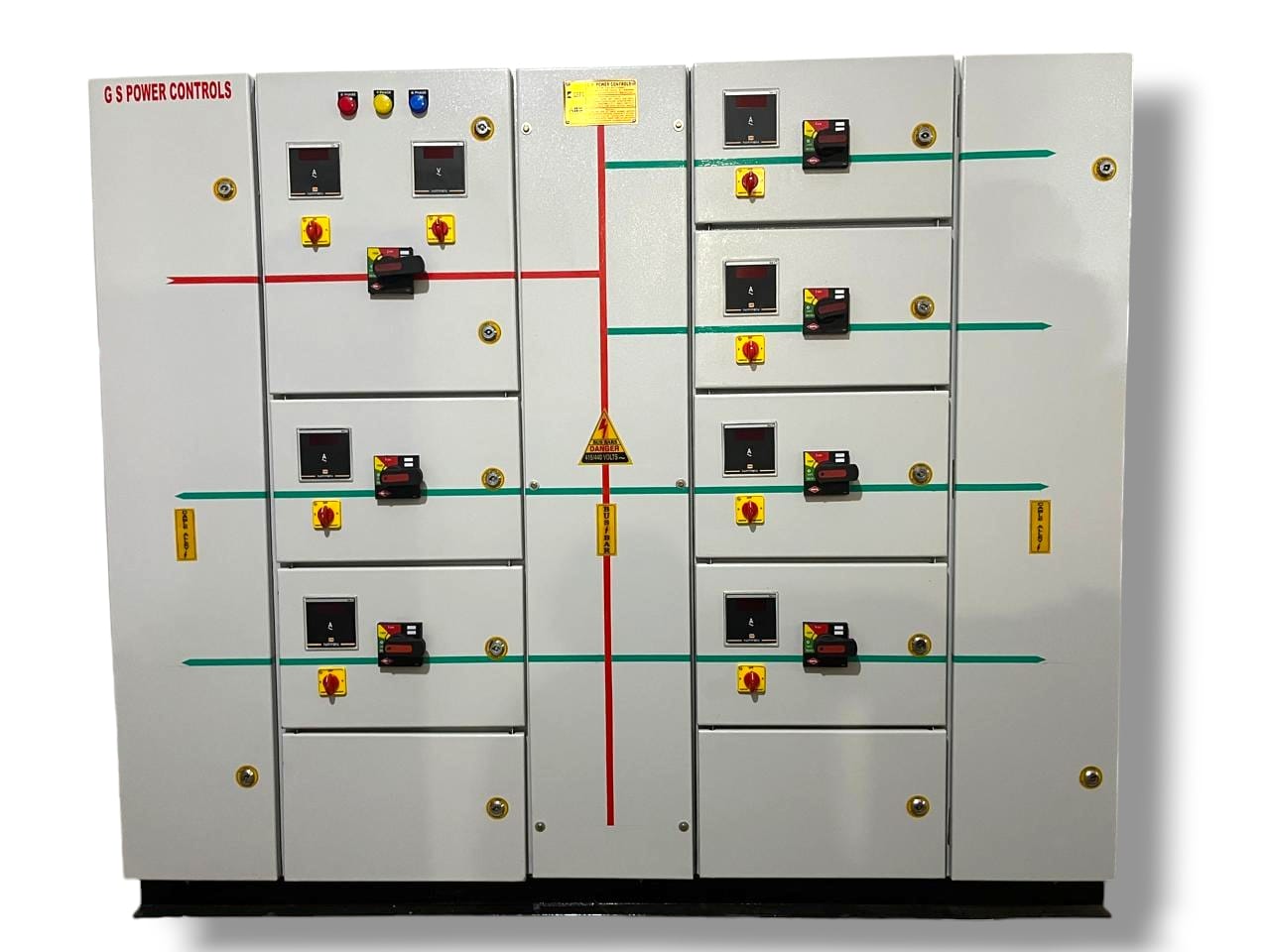fFIRE PUMP PANEL A **Fire Pump Panel** is a crucial component of a fire protection system in buildings, industrial facilities, and other large structures. It is used to control the operation of the fire pump, which ensures that there is adequate water pressure and flow to fight fires in case of an emergency. Here are the key components and functions of a fire pump panel: ### Key Components of a Fire Pump Panel: 1. **Pump Start/Stop Buttons**: - These buttons are used to manually start or stop the fire pump during an emergency or maintenance. 2. **Automatic Start/Stop Controls**: - Fire pumps are typically designed to start automatically when a drop in pressure is detected in the system or when a fire alarm is triggered. This is usually managed by the pressure switches and the fire alarm system. 3. **Pressure Switches**: - Pressure switches detect changes in the water pressure within the fire protection system (such as a drop in pressure caused by a fire) and automatically activate the pump to restore proper pressure. 4. **Pump Motor Protection**: - Protects the pump motor from electrical faults like overloads, short circuits, or phase failure. This ensures the motor is running safely and efficiently. 5. **Water Flow Switch**: - Detects water flow within the system. If water flow is detected, it sends a signal to start the pump. If no flow is detected when it’s needed, the system will generate an alarm. 6. **Power Supply and Backup**: - The fire pump panel is usually powered by the main electrical supply, but it must also have a backup power source, like a generator or battery, in case of power failure during a fire emergency. 7. **Alarms**: - The panel has visual and audible alarms that alert personnel to issues such as pump failure, low water pressure, or other faults. This helps ensure that the system is always in working order. 8. **Control Valves**: - The panel may also control and monitor various valves in the system, such as pressure relief valves or isolation valves, to maintain proper water pressure and flow. 9. **Indicators and Meters**: - There are typically gauges that monitor key parameters, such as pressure, temperature, and pump status. These indicators help ensure the pump is functioning properly and that the system is ready to respond in case of an emergency. 10. **Test Functions**: - Many fire pump panels have a test mode that allows the system to be tested without triggering an actual alarm or emergency response. This is important for routine maintenance and checks. ### Types of Fire Pump Panels: 1. **Electric Fire Pump Panels**: - These panels control electric-powered fire pumps, commonly used in buildings with reliable electrical supply. 2. **Diesel Fire Pump Panels**: - These are used in systems where the fire pump is powered by a diesel engine, often employed in locations where electricity might be unreliable or unavailable. 3. **Jockey Pump Panels**: - These are smaller pumps used to maintain pressure in the system when the fire pump is not running. Jockey pump panels ensure the system
Chat with us on WhatsApp
×
This is your website preview.
Currently it only shows your basic business info. Start adding relevant business details such as description, images and products or services to gain your customers attention by using Boost 360 android app / iOS App / web portal.
https://www.gspowercontrols.com/latest-update/ffire-pump-panel-a-fire-pump-panel-is-a-crucia/5
fFIRE PUMP PANEL A **Fire Pump Panel** is a crucia...

2024-11-14T13:51:11
fFIRE PUMP PANEL A **Fire Pump Panel** is a crucial component of a fire protection system in buildings, industrial facilities, and other large structures. It is used to control the operation of the fire pump, which ensures that there is adequate water pressure and flow to fight fires in case of an emergency. Here are the key components and functions of a fire pump panel: ### Key Components of a Fire Pump Panel: 1. **Pump Start/Stop Buttons**: - These buttons are used to manually start or stop the fire pump during an emergency or maintenance. 2. **Automatic Start/Stop Controls**: - Fire pumps are typically designed to start automatically when a drop in pressure is detected in the system or when a fire alarm is triggered. This is usually managed by the pressure switches and the fire alarm system. 3. **Pressure Switches**: - Pressure switches detect changes in the water pressure within the fire protection system (such as a drop in pressure caused by a fire) and automatically activate the pump to restore proper pressure. 4. **Pump Motor Protection**: - Protects the pump motor from electrical faults like overloads, short circuits, or phase failure. This ensures the motor is running safely and efficiently. 5. **Water Flow Switch**: - Detects water flow within the system. If water flow is detected, it sends a signal to start the pump. If no flow is detected when it’s needed, the system will generate an alarm. 6. **Power Supply and Backup**: - The fire pump panel is usually powered by the main electrical supply, but it must also have a backup power source, like a generator or battery, in case of power failure during a fire emergency. 7. **Alarms**: - The panel has visual and audible alarms that alert personnel to issues such as pump failure, low water pressure, or other faults. This helps ensure that the system is always in working order. 8. **Control Valves**: - The panel may also control and monitor various valves in the system, such as pressure relief valves or isolation valves, to maintain proper water pressure and flow. 9. **Indicators and Meters**: - There are typically gauges that monitor key parameters, such as pressure, temperature, and pump status. These indicators help ensure the pump is functioning properly and that the system is ready to respond in case of an emergency. 10. **Test Functions**: - Many fire pump panels have a test mode that allows the system to be tested without triggering an actual alarm or emergency response. This is important for routine maintenance and checks. ### Types of Fire Pump Panels: 1. **Electric Fire Pump Panels**: - These panels control electric-powered fire pumps, commonly used in buildings with reliable electrical supply. 2. **Diesel Fire Pump Panels**: - These are used in systems where the fire pump is powered by a diesel engine, often employed in locations where electricity might be unreliable or unavailable. 3. **Jockey Pump Panels**: - These are smaller pumps used to maintain pressure in the system when the fire pump is not running. Jockey pump panels ensure the system
2024-11-14T13:51:11
Keywords
- test mode
- pump motor
- pump status
- actual alarm
- pump failure
- other faults
- diesel engine
- working order
- phase failure
- smaller pumps
- power failure
- key parameters
- audible alarms
- short circuits
- key components
- fire emergency
- various valves
- Control Valves
- proper pressure
- isolation valves
- fFIRE PUMP PANEL
- pressure switches
- crucial component
- electrical faults
- fire alarm system
- emergency response
- low water pressure
- Jockey pump panels
- routine maintenance
- backup power source
- A **Fire Pump Panel
- industrial facilities
- proper water pressure
- Many fire pump panels
- fire protection system
- 5. **Water Flow Switch
- pressure relief valves
- other large structures
- main electrical supply
- adequate water pressure
- reliable electrical supply
- electric-powered fire pumps

Submit Your Enquiry